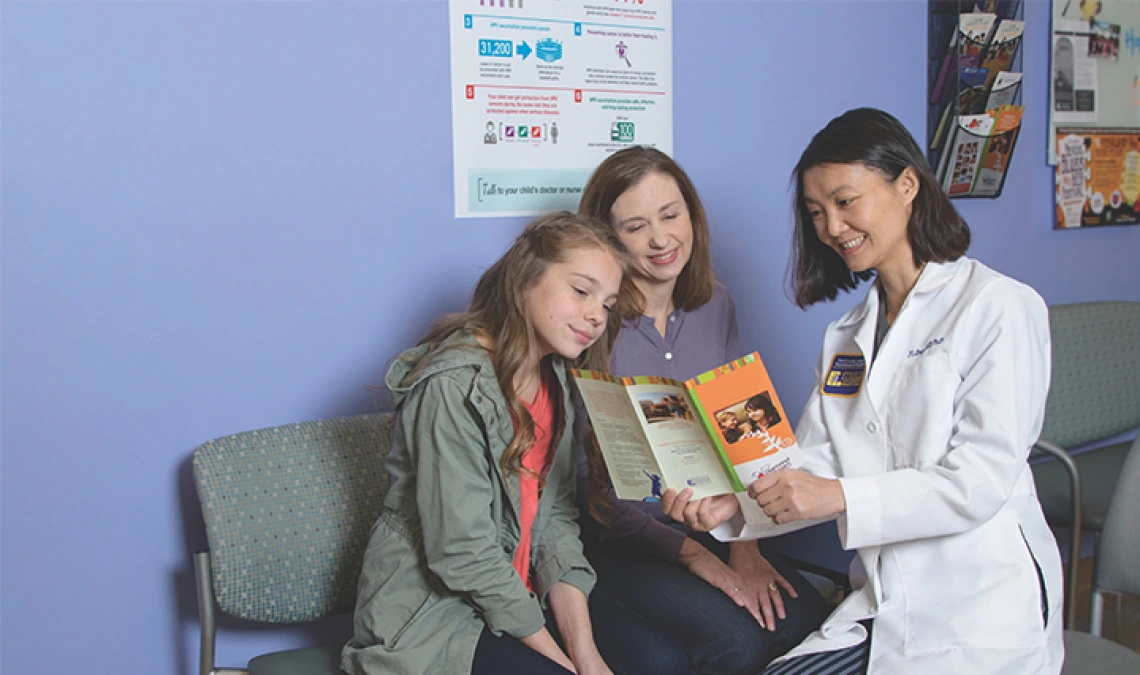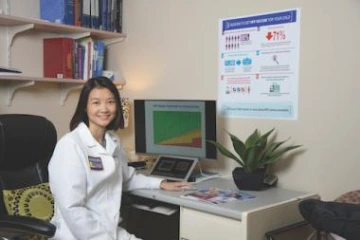A Shot at Prevention
By learning about their immune response, we could defend more children against a cancer-causing virus.

Yi Zeng, MD, PhD, hopes more preteens and teens will receive the HPV vaccine.
Vaccines have helped transform our relationship with infectious diseases. In parts of the world with widespread vaccination, fatal illnesses like measles and whooping cough no longer inspire fear. Rather than fretting over microbes, most of us reading this are more concerned about chronic diseases like diabetes, heart disease and cancer.
A handful of cancers, however, are vaccine preventable — including cervical cancer and anal cancer, which almost are exclusively caused by human papillomavirus, aka HPV. This common virus also can cause head-and-neck, vaginal, vulvar and penile cancers. Overall, HPV is responsible for about 1 out of 20 cancers worldwide.
Fortunately, preteens and teens can be protected by the HPV vaccine. Since its debut in 2006, HPV infections have declined, and HPV-associated cancer rates are projected to nosedive as well. Previous versions protected against two cancer-causing strains of HPV, but the latest HPV vaccine, Gardasil 9, protects against seven cancer-causing strains.
Unfortunately, in 2017, only 49 percent of 13- to 17-year-olds were up to date on their HPV vaccinations, falling short of the Department of Health and Human Services’ goal to achieve an 80-percent vaccination rate by 2020. Many barriers stand in the way of that goal. One is that the vaccination series requires kids to receive multiple shots over the course of six months.
“It’s the logistics,” says Yi Zeng, MD, PhD, associate professor of pediatrics at the University of Arizona College of Medicine – Tucson. “Preteen and teenage girls and boys are busy. Requiring them to take time off from school and their other activities to come to the doctor’s office is a challenge.”
When the vaccine first was approved, recipients typically were given a first shot, a second shot two months later and a third shot four months after that.
“Most kids don’t get the three doses,” Dr. Zeng says. “Three vaccines within a six-month period is a lot to ask of a teenager and their parents.”
Fortunately, as we learn more about the vaccine, recommendations are changing. We now know that younger recipients — those between 9 and 14 years of age, whose immune responses to HPV vaccines are stronger — receive protection from just two doses. (Older recipients still get three doses.) Two shots instead of three save a trip to the doctor — thus saving the time parents have to take off from work and allowing kids to avoid the extra sting of a needle.

Yi Zeng, MD, PhD
But some studies, looking at earlier versions of the vaccine, have hinted that one dose might be all it takes to give a young person lasting protection. So, what about Gardasil 9? That’s the question Dr. Zeng is hoping to answer. With support from the National Cancer Institute, she is at the helm of a clinical trial taking place at the UA Cancer Center and UCLA. The trial has enrolled nearly 200 preteens, ages 9 to 11, and is tracking their immune response to a single dose of Gardasil 9.
Whenever the immune system encounters a “bad bug” — or, in the case of the HPV vaccine, an inert protein that exactly mimics the virus’s outer shell — it responds by manufacturing customized proteins called antibodies, which lock onto a pathogen and “tag” it for destruction. As long as our blood contains sufficient numbers of these custom-made antibodies, our immune systems can protect us from these bugs if we encounter them in our daily lives. We can test a patient’s immunity by looking at blood samples, which Dr. Zeng’s team takes from trial participants every six months over a two-year period.
“We hope one dose gives our study participants a sustainable level of antibodies,” Dr. Zeng says. “If our data support our hypothesis, in the future, kids may need only one dose of Gardasil 9.”
At the outset, Dr. Zeng’s team was worried it might be difficult to recruit participants to their study — and keep them coming back every six months to give blood samples.
“There were a lot of uncertainties about how we were going to retain the patients, because we plan to poke them,” Dr. Zeng says with a laugh. “But it worked out very well.”
One reason Dr. Zeng believes the study has been so successful in holding onto participants is its flexibility.
“How do you convince busy kids and busy parents to come to the clinic to do this?” she asks. “We offered them a very flexible schedule, like very early or very late appointments to accommodate their needs.”
Although Dr. Zeng was initially only looking at girls’ immune responses, her team quickly opened enrollment to boys in response to demand.
“The brothers of some of our participants asked, ‘When can I get my vaccine?'" Dr. Zeng recalls. “The NCI decided to expand the study, so we were able to recruit boys of the same age group.”
Study participants still get the FDA-recommended two doses of the vaccine — they just wait 24 months to receive the second shot, allowing researchers to monitor antibody levels over a two-year period, and allowing children to stay in compliance with current FDA recommendations.
The last participant is expected to complete the final study visit in February 2020. If the results show that children maintain sufficient levels of antibodies in their blood, larger studies will be designed to answer further questions about a possible one-dose regimen more definitively. If HPV protection could be obtained with just one visit to the doctor’s office, children would have one less barrier standing between them and cancer prevention.
“I’m hoping more boys and girls will be immunized,” Dr. Zeng says. “Hopefully in the future, we’ll decrease HPV-related cancers and diseases in women and men.”




